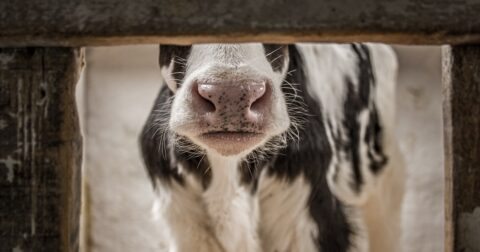Explainer
Do Government Subsidies Make Meat Cheaper? Yes, but With Some Important Caveats
Meat Lobby•10 min read
Perspective
Agriculture Secretary Tom Vilsack recently announced that USDA will begin a new process to address farmed animal welfare standards. It's long overdue.


Words by Tracie Letterman
In recent years, with breathtaking speed and scope, multinational firms involved with food production, distribution, sales, and service have committed themselves to the elimination of intensive confinement factory farming through reforms in their corporate supply chains. These reforms in turn have cascaded throughout our food retail universe, making it possible for consumers to exercise meaningful choices—choices consistent with their personal ethics, their nutrition and health goals, and the needs of their families, their communities, and the natural environment.
Together, we must work to ensure that the same mindset takes hold within the federal government, especially at the United States Department of Agriculture. Under the Obama Administration, USDA issued an animal welfare-focused Organic Livestock and Poultry Practices Rule in 2017 but it was withdrawn in 2018 before it went into effect under the Trump Administration. The rule was informed by many years of public input, including the powerful example of a landmark California law, which set clear standards for animal welfare.
Agriculture Secretary Tom Vilsack recently announced that USDA will reconsider the previous administration’s position on this rule and begin a new process to address animal welfare standards. Resurrecting the rule is vital to maintaining consumer confidence in the USDA organic label and its National Organic Program, which develops and enforces consistent national standards for all USDA-certified organic products.
Certainly, the humane provisions from the 2017 rule should be part of the anticipated new rule USDA now plans to draft. The 2017 rule prohibited tail docking of cattle, debeaking and toe-clipping of chickens, and the transportation of “downer” animals—those too sick or injured or weakened to walk to their own slaughter. Consistent with the 2017 rule, a new standard should ensure that animals are not tightly confined. Shelters provided must allow enough space for animals to lie down, stand up, and fully stretch their limbs without touching other animals or the sides of the shelter and standards should set minimum indoor space requirements for egg-laying chickens.
Importantly, the new proposal should include language from 2017 that closed a loophole in current regulations exploited by large poultry companies using screened-in porches to satisfy outdoor access requirements. All species should have outdoor access to soil, direct sunlight, fresh air, and clean water for drinking.
The case for such a rule has not changed since 2017. We need it to better align organic standards with consumer expectations. To that point, a 2017 Consumer Reports survey found that six out of 10 Americans consider it highly important that animals used to produce organic food be raised on farms with high standards for animal welfare. Among consumers who always or often buy organic, 86 percent believe it is highly important that such animals be raised on farms with high standards for animal welfare.
My colleagues at the Humane Society Legislative Fund and the Humane Society of the United States focus on attempts to stymy, constrain, or close out factory farming through legislation, litigation, corporate social reform, consumer education and other means, and we need that. But we also need to promote and build out a future vision for the treatment of animals in the food supply, and we need to institutionalize the core elements of that vision within government agencies like the USDA.
That’s one of the great virtues of this rule. According to industry data, organics is now a market valued at over $50 billion in sales, and within the sector, organic dairy, eggs, and meat products are gaining ground. Because of the considerable overlap between organic and higher welfare approaches, this is a portion of the market we should do our best to strengthen and protect. An authentic animal welfare standard for organic production will be a bulwark of a new and more humane marketplace.
There are countless consumers who want to see the National Organic Program establish criteria in line with their expectations for how animals should be treated before slaughter. Over the last two decades, even more Americans have consistently demonstrated their support for the passage and implementation of farmed animal welfare laws at the state level through legislation or ballot and referendum measures. With its prompt development and implementation of the organic animal welfare rule, the USDA under Secretary Vilsack can place a key agency program at the forefront of a stronger federal commitment to farmed animal welfare, and lay the groundwork for a deeper, broader, and longer-range commitment to the better treatment of animals used for food.